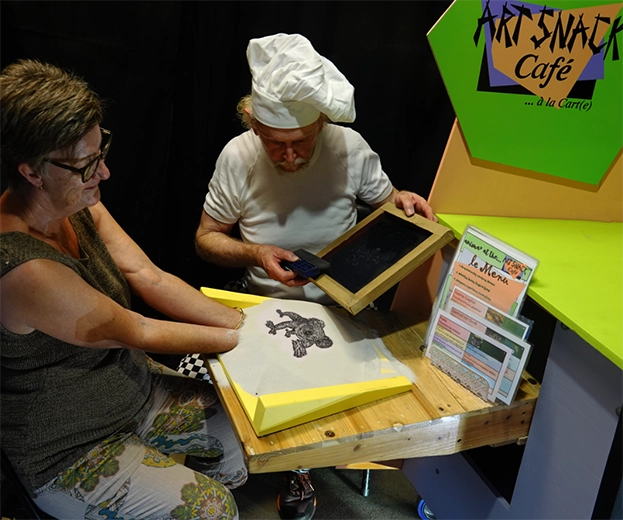Art Snack Café - à la Cart(e)

Alan Tulloch
Art Snack Café - à la Cart(e) 2025
Timber, steel affixives, wheels, sand, charcoal, and concrete blocks as ballast
236 x 200 x 108 cm
About the Work
Alan Tulloch extends his innovative dry media print performances and installations through his Art Snack Café - à la Cart(e), presenting relational 3D print performances, strategically wheeling his Café along The Strand. He dons toque blanche and chequered pants to become Art Chef, cooking up not-so-normal cuisine in the form of threatened-to-extinct Townsville animals.
Menu items appear in a stroke, printing enticing and malleable images on patrons’ hands using powdered charcoal. Tulloch nudges old-school passivity away from charcoal to critically rearticulate it as incinerated life. The prints of threatened-to-extinct animals become materially connected with the passing of life. But all is not lost, visitors are encouraged to move their fingers to enliven their images, but the prints eventually disappear into the sands of time. Trace-less?
This is ephemeral (plus); this is moving (body, heart and hands); this is trace-less, (almost!). Some consolation arises through the Cafe’s dine-in and takeaway options, with facilities for visitors to record their Art Snack Cafe experiences on their mobile phones.
About the Artist
Ipswich artist Alan Tulloch has been developing a technique of dry media screen printing installations and performances since 2015, preceded by a much earlier floor stencil artwork, Carpet (1997). He has shown resultant work in projects between Bimblebox, north of Alpha, QLD (2015), and south to Rookwood, west of Sydney (2022) and Port Adelaide Enfield (2020) and is ever-keen to extend this technique and its multi-location applicability. In 2017, he won a Digital Queensland Regional Art Award, Float, printing a map of Queensland and the Galilee Coal Basin with coal dust onto water.
As well as making works site-specific in focus, he often uses the materials of place (his dry media) to tell the stories of place. He rarely uses binding media or fixatives. Prints are left on the ground or other horizontal surfaces to dissipate, as they are subjected to elemental, animal, or mechanical actions.